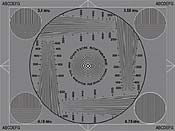Behind The Numbers Page 2
At the opposite end of the video dynamic range, setup level indicates what IRE setting the player uses to represent black. The level for the direct-view monitors used in TV studios and during DVD mastering is normally +7.5 IRE, and setup discs like Ovation Software's Avia also aim for that level. Any monitor/player mismatch here - specifically, the use of an "expanded" or "enhanced" black-level setting of 0 IRE in the player - will throw off the brightness scale on a TV adjusted for the +7.5-IRE standard. While this has the effect of increasing contrast, which many people find appealing, it also reduces the amount of detail visible in dark images or deep shadows.
Differential gain and differential phase are two traditional composite-video measurements that are helpful in evaluating videotape recorders but are not especially relevant to the quality of a DVD player. We continue to run them for comparison with other devices. Differential phase indicates how much the color shifts as the point-to-point brightness of the picture changes, and differential gain indicates how much the brightness of the picture changes as the color shifts. Unless there's a direct comparison with a reference image, the eye is extremely tolerant of larger errors in both these parameters, especially differential gain, than we have ever measured from a DVD player.
Luminance frequency response (formerly called "horizontal luminance frequency response") is the best way to judge a DVD player's resolution performance. This measurement allows you to decide whether the picture detail you're seeing comes from accurate playback (a flat response with ±0-dB error up to 6.75 MHz) or from a "goosed" response (+0.5 dB or more between 4 and 6 MHz), which can make a picture seem sharper without necessarily conveying very fine detail. Better players will have flatter response up to a higher frequency than one that rolls off or has a "midrange" boost.
If you're deciding between a player that rolls off slowly at the higher frequencies (say, -1 dB at 4 MHz, -3 dB at 5 MHz, and -8 dB at 6.75 MHz) and one that is flat throughout the range but down 10 dB or more at 6.75 MHz (the DVD-Video format's limit), choose the latter. A player that has flat response will provide a sharper-looking picture than one that rolls off.
 To cross check our luminance-response measurements, and to give readers a resolution figure with the more familiar "lines of resolution" as the units, we use onscreen horizontal resolution (formerly just "onscreen resolution"). It's one of two DVD player tests we make (the other is in-player letterboxing) that are judgment calls, meaning that the numbers aren't spit out by a machine. Each requires looking at a test pattern on a TV screen and deciding what the result is for that test. The test pattern in this case is the 200-line resolution "wedge" chart of the Avia test DVD. The area we look at is the bottom of the righthand vertical wedge, and what we look for is the point where the closely spaced vertical lines turn to a gray mush, with no vertical line structure visible. That point, if it occurs at all before the bottom of the wedge is reached, is converted to a resolution measurement by reading off the scale next to the grayed-out point of the wedge.
To cross check our luminance-response measurements, and to give readers a resolution figure with the more familiar "lines of resolution" as the units, we use onscreen horizontal resolution (formerly just "onscreen resolution"). It's one of two DVD player tests we make (the other is in-player letterboxing) that are judgment calls, meaning that the numbers aren't spit out by a machine. Each requires looking at a test pattern on a TV screen and deciding what the result is for that test. The test pattern in this case is the 200-line resolution "wedge" chart of the Avia test DVD. The area we look at is the bottom of the righthand vertical wedge, and what we look for is the point where the closely spaced vertical lines turn to a gray mush, with no vertical line structure visible. That point, if it occurs at all before the bottom of the wedge is reached, is converted to a resolution measurement by reading off the scale next to the grayed-out point of the wedge.
Nearly all DVD players have enough output at the format's resolution limit of 540 lines (equivalent to the 6.75-MHz limit for luminance frequency response) to merit a 540-line reading for onscreen horizontal resolution. The few that don't still might not look obviously "soft" with movies, because their response at lower frequencies is flat or boosted and because the amount of fine detail that benefits from full 540-line resolution is small.
























































